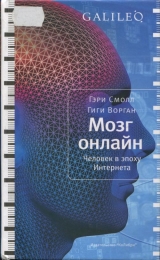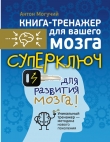
Текст книги "Мозг онлайн. Человек в эпоху Интернета"
Автор книги: Гэри Смолл
Соавторы: Гиги Ворган
сообщить о нарушении
Текущая страница: 15 (всего у книги 15 страниц)
166. Interactive Marketing & Media Fact Pack 2006. Crain Communications Inc. April 17, 2006, http://adage.com/images/random/Interactivefactpacko6.pdf
167. Darlin D.Using the Web to get the boss to pay more. The New York Times. March 3, 2007
168. Atkinson R. D., McKay A.Digital prosperity: Understanding the economic benefits of the information technolog у revolution. The Information Technology & Innovation Foundation. March 2007, http://www.itif.org/files/digital_prosperity.pdf
169. Kuhnen C. M., Knutson B.The neural basis of financial risk taking. Neuron 2005; 47:763-770
170. Hsu М., Bhatt М., Adolphs R., Tranel D., Camerer C. F.Neural systems responding to degrees of uncertainty in human decision-making. Science 2005; 310: 1680-1683
171. NAA releases ABC FAX-FAX analysis, www.naa.org/Global/PressCenter/2006/NAA-RELEASES-ABC-FAS-FAXANALYSIS.aspx?lg=naaorg
172. Carr D.Threatened by the Internet, Time Magazine slims down. The New York Times. January 8, 2007
173. Ciepły M.New show to begin on MySpace. The New York Times. September 13, 2007
174. Online ad revenue sets record for a third year. The Wall Street Journal. March 8, 2007
175. Kehaulani Goo S.Google gambles on Web video. The Washington Post. October 10, 2006, http://www.washington-post.com/wp-dyn/content/article/2006/10/09/AR2006100900546.html
176. Fallows D. How men and women use the Internet. Pew Internet & American Life Project. Washington, DC, 2005.
177. Baron-Cohen S., Knickmeyer R. C., Belmonte M. K.Sex differences in the brain: Implications for explaining autism. Science 2005; 4:310:819-823
178. Haier R. J., Jung R. E., Yeo R. A., Head K., Alkire M. T.The neuroanatomy of general intelligence: sex matters. Neuroimage 2005; 25:320–327.
179. Fallows D.How men and women use the Internet. Pew Internet & American Life Project. Washington, DC, 2005
180. The mismeasure of woman. The Economist. August 3, 2006, www.economist.com/science/displaystory.cfm?story_id=7245949
181. Fulkerson J.A., Story М., Mellin A., Leffert N.. Neumark-Sztainer D., French S. A.Family dinner meal frequency and adolescent development: Relationships with developmental assets and high-risk behaviors. Journal of Adolescent Health 2006; 39:337-345
182. Madden М., Lenhart A.Online dating. Pew Internet & American Life Project. March 5, 2006, www.pewinternet.org/pdfs/PIP_Online_Dating.pdf
183. Zaslow J.Digital love letters are easy to send but hard to cherish. The Wall Street Journal. February 9, 2007
184. Fisher H. E., Aron A., Brown L. L.Romantic love: A mammalian brain system for mate choice. Philosophical Transactions of the Royal Society of London. Series B. Biological Sciences 2006: 361: 2173-2186
185. Hafner K.Laptop slides into bed in love triangle. The New York Times. August 24, 2006.
186. Zeller T.Your life as an open book. The New York Times. August 12, 2006.
187. National Center for Health Statistics. Electronic medical record use by office-based physicians: United States, 2005, www.cdc.gov/nchs/products/pubs/pubd/hestats/electronic/electronic.htm
188. Stone J. H.Communication between physicians and patients in the era of e-medicine. The New England Journal of Medicine, 2007; 356:2451-2454
189. Dell К., Cullen LT.Snooping bosses. Time. September 11, 2006, http://www.workrights.org/in_the_news/in_the_news_time.html
190. Geller A.Bosses keep sharp eye on mobile workers via GPS. Associated Press. January 3, 2005, http:// www.workrights.org/in_the_news/in_the_news_associatedpress.html
191. Finder A.For some, online persona undermines a resume. The New York Times. June 11, 206
192. Cohen R.Online extracurriculars. The New York Times Sunday Magazine. March 11, 2007
193. Sullivan M.S.Law May Curb Cellphone Camera Use. PCWorld.com. July 23, 2004, www.pcworld.com/article/id,117035-page,1/article.html
194. Bryan-Low C.To catch crooks in cyberspace, FBI goes global. The Wall Street Journal. November 21, 2006
195. Meyer J.Extremists are homing in on the Internet, says Gonzales. Los Angeles Times. August 17, 2006
196. Bloom F. E., Beal M. F., Kupfer D. J. (eds).The Dana Guide to Brain Health. The Dana Press. New York, 2003
197. Nitschke J. B., Sarinopoulos I., Mackiewicz K. L, Schaefer H. S., Davidson R. J.Functional neuroanatomy of aversion and its anticipation. Neuroimage 2006; 29:106-116
198. Cohen L. P.Internet’s ubiquity multiplies venues to try web crimes. The Wall Street Journal. February 12, 2007
199. Bryan-Low С.To catch crooks in cyberspace, FBI goes global. The Wall Street Journal. November 21, 2006
200. Yuan LMurder, she texted: Wireless messaging used to fight crime. The Wall Street Journal. July 2, 2007
201. Saranow J.The minutes of our lives. The Wall Street Journal. March 2, 2007
202. Lenhart A., Fox S. Bloggers: A portrait of the internet’s new storytellers. Pew Internet & American Life Project. Washington, DC, 2006
203. Studios enlist blowers for Oscar campaigns, ruffling feathers in Hollywood hierarchy. The Wall Street Journal. February 8, 2007
204. Nagourney A.Politics faces sweeping change via the Web. The New York Times. April 2, 2006. www.workrights.org/in_the_news/in_the_news_associatedpress.html
Schatz A.Candidates find a new stump in the blogosphere. The Wall Street Journal. February 14, 2007
205. Comscore.com. Social networking sites continue to attract record numbers as MySpace.com surpasses 50 million U.S. visitors in May. June 15, 2006, www.comscore.com/press/release.asp?press=906
206. Noveck J.YouTube follows the campaign trail. Los Angeles Times. July 6, 2007
207. The Internet’s broader role in Campaign 2008. Pew Internet & American Life Project. January 11, 2008. http://pewresearch.org/pubs/689/the-internetsbroader-role-in-campaign-2008
208. PQ Media’s Po litical Media Buying 2008: Preliminary Forecast Analysis. http://www.pqmedia.com/political-media-buying-2008.html
209. Amodio D. M., Jost J. T., Master S. L, Yee C. M.Neurocognitive correlates of liberalism and conservatism. Nature Neuroscience 2007; 10: 1246-1247
210. Kaplan J. T., Freedman J., Iacoboni M.Us versus them: political attitudes and party affiliation influence neural response to faces of presidential candidates. Neuropsychologia 2007; 45:55-64
Глава 6. Эволюция мозга: где мы теперь?
211. Ercoli LM, Siddarth Р, Huang S-C, et al. Perceived loss of memory ability and cerebral metabolic decline in persons with the apolipoprotein E-4 genetic risk for Alzheimer’s disease. Archives of General Psychiatry 2006; 63:442-448
Глава 7. Снова лицом к лицу
212. Silverstein S.Real world 101: Colleges teach dining, taxes, life. Los Angeles Times. June 10, 2006
213. Ybarra O., Burnstein E., Winkielmon P.,et al. Mental exercising through simple socializing: Social interaction promotes general cognitive functioning. Personality and Social Psycholog у Bulletin 2008; 34:248-59
214. ChayerC., Freedman M.Frontal lobe functions. Current Neurolog y and Neuroscience Reports 2001; 1:547.
215. Blakeslee S.A small part of the brain, and its profound effects. The New York Times. February 6, 2007
216. Naqvi N.H., Rudrauf D., Damasio H., Bechara A.Damage to the insula disrupts addiction to cigarette smoking. Science 2007; 315: 531–534.
217. Koenigs М., Young L, Adolphs R., et al.Damage to the prefrontal cortex increases utilitarian moral judgments. Nature 2007; 446:865-866
Carey B.Brain injury said to affect moral choices. The New York Times. March 22, 2007
218. King J. A., Blair J. R., Mitchell D. G. X, Dolan R. J., Burgess N.Doing the right thing: A common neural circuit for appropriate violent or compassionate behavior. Neuroimage 2006; 30:1069-1076
219. Williams L. M., Brown K. J., Palmer D.,et al. The mellow years?: Neural basis of improving emotional stability over age. Journal of Neuroscience 2006; 26:6422-6430
220. Begley S.Parts of brain seem to get better with age. The Wall Street Journal. February 17, 2007
221. The teen driver: Committee on Injury, Violence, and Poison Prevention and Committee on Adolescence. Pediatrics 2006; 118:2570-2581
222. Centers for Disease Control and Prevention. Webbased Injury Statistics Query and Reporting System (WISQARS) [Online]. (2006). National Center for Injury Prevention and Control, Centers for Disease Control and Prevention (producer), www.cdc.gov/ncipc/wisqars
223. Williams et al.Journal of Neuroscience 2006: 26: 6422-6430
224. Leclerc C. M., Hess Т. M.Age differences in the bases for social judgments: Tests of a social expertise perspective. Experimental Aging Research 2007; 33:95-120
Begley S.The upside of aging. The Wall Street Journal. February 17, 2007.
225. Foreman J.It seems all those birthdays may be making you happy. Los Angeles Times. July 16, 2007
226. Bradley S.Foregrounding language. On the relationship between therapeutic words and the brain. Psychiatric Annals 2006; 36:289-294
Schwartz J.M., Stoessel P.W., Baxter L. R., Martin K. M., Phelps M. E.Systemic changes in cerebral glucose metabolic rate after successful behavior modification treatment of obsessive-compulsive disorder. Archives of General Psychiatry 1996; 53:109-113
227. Koezuka N.. Koo М., Allison K. R.,et al. The relationship between sedentary activities and physical inactivity among adolescents: Results from the Canadian community health survey. Journal of Adolescent Health 2006; 39:515-522
228. Smallet al. American Journal of Geriatric Psychiatry 2006; 14:538-545
229. Small G., Vorgan G.The Longevity Bible. Hyperion, New York, 2006. Begley S. How to keep your aging brain fi t: Aerobics. The Wall Street Journal. November 16, 2006
230. Wang A. T., LeeS.S., Sigman М., Dapretto M.Reading affect in the face and voice. Neural correlates of interpreting communicative intent in children and adolescents with autism spectrum disorders. Archives of General Psychiatry 2007; 64:698-708
231. Joinson A. N.Selfesteem, interpersonal risk, and preference for e-mail to face-to-face communication. CyberPsychology & Behavior 2004; 7:472-478
232. Joinson A. N.Cyberpsychology & Behavior 2004; 7:472-478
233. Suler J.The online disinhibition effect. Cyber-Psychology & Behavior 2004; 7:321-326
234. Harmon A.Internet gives teenage bullies weapons to wound from afar. The New York Times. August 26, 2004
235. New A. S., Hazlett E. A., Buchsbaum M. S.,et al. Blunted prefrontal cortical 18fluorodeoxyglucose positron emission tomography response to metachlorophenylpiperazine in impulsive aggression. Arch Gen Psychiatry 2002; 59:621-629
236. Sharot Т., Riccardi A. M., Raio C. M., Phelps E. A.Neural mechanisms mediating optimism bias. Nature 2007: 450: 102-105
237. Carr L, Iacoboni М., Dubeau М.-C., Mazziotta J. C., Lenz G. LNeural mechanisms of empathy in humans: A relay from neural systems for imitation to limbic areas. Proceedings of the National Academy of Science USA 2003; 100:5497–5502.
238. Singer Т., Seymour B., O’Doherty J., Kaube H., Dolan R. J., Frith C. D.Empathy for pain involves the affective but not sensory components of pain. Science 2004; 303:1157-1162
239. Thompson С.Meet the life hackers. The New York Times. October 16, 2005.
240. Davidson R. J., Kabat-Zinn J., Schumacher J.,et al. Alterations in brain and immune function produced by mindfulness meditation. Psychosomatic Medicine 2003; 65:564-570
Geirland J.Buddha on the brain: The hot new frontier of neuroscience: Meditation! (justask the Dalai Lama.) Wired. February 2006, www.wired.com/wired/archive/14.02/dalai.html
241. Small G., Vorgan G.The Longevity Bible. Hyperion, New York, 2006
242. Wing A. M.Motor control: Mechanisms of motor equivalence in handwriting. Current Biology 2000; 10:245-248
Глава 8. Технологический багаж
243. Вот С., Meindl Т., Poeppel Е.,et al. Brand perception: Evaluation of cortical activation using f MRI. Annual Meeting of the Radiological Society of North America, November 28, 2006
244. Hsu М., Bhatt М., Adolphs R., Tranel D., Camerer C. F.Neural systems responding to degrees of uncertainty in human decision-making. Science 2005: 310: 1680–1683.
245. Shipley D., Schwalbe W.Send. Alfred A. Knopf, New York, NY, 2007.
246. Barbara М., Zeller T.A Face Is Exposed for AOL Searcher № 4417749. The New York Times. August 9, 2006
247. Richtel М.Hands on the wheel, not on the BlackBerry keys. The New York Times. May 12, 2007
Cooper C.Legislators aim at a new misdeed on the road: DWT. The Wall Street Journal. March 14, 2007
248. Insurance Information Institute, Inc. Cell Phones and Driving, http://www.iii.org/media/hottopics/insurance/cellphones/
249. Strayer D. L, Drews F. A., Crouch D. J.A comparison of the cellphone driver and the drunk driver. Human Factors 2006; 48:381–391.
250. Osaka М., Komori М., Morishita М., Osaka N.Neural bases of focusing attention in working memory: an FMRI study based on group differences. Cognition Affective Behavioral Neuroscience 2007; 7:130–139.
251. Wood J., Chaparro A., Hickson L.,et al. The effect of auditory and visual distracters on the useful field of view: Implications for the driving task. Investigative Ophthalmology and Visual Science. 2006: 47:4646–4650.
252. White B.TV channels move to the Web, think outside the cable box. The Wall Street Journal. August 20, 2007
253. Declerck C. H., Boone C., De Brabander B.On feeling in control: a biological theory for individual differences in control perception. Brain and Cognition 2007: 62:143-176
254. Mobbs D., Petrovic P., Marchant J. L,et al. When fear is near: Threat imminence elicits prefrontalperiaqueductal gray shifts in humans. Science 2007; 317:1079–1083.
255. Secretary Nicholson provides update on stolen data incident: Data matching with Department of Defense providing new details. U.S. Department of Veterans Affairs, http://www1.va.gov/opa/pressrel/pressrelease.cfm?id=1134
256. University of Massachusetts Lowell, IT department, www.uml.edu/it/default.html
257. Zetter K.How best to protect kids from online porn. San Francisco Chronicle. February 12, 2006, http://www.sfgate.com/cgi-bin/article.cgi?f=/c/a/2006/02/12/FILTERING.TMP
258. Pham A., Menn J.Google Maps redraw the realm of privacy. Los Angeles Times. August 7, 2007
259. Burton T. M., Wilde Mathews A.Monitoring your heart via the Internet. The Wall Street Journal. February 28, 2007
260. Fox S.Online health search 2006. Pew Internet & American Life Project. October 29, 2006, www.pewinternet.org/pdfs/PIP_Online_Health_2006.pdf
261. Kushner D.Well connected: Finding trustworthy medical info online. AARP March & April 2007; 40-42
262. Van den Heuvel O. A., Veltman D. J., Groenewegen H. J.,et al. Disorder-specific neuroanatomical correlates of attentional bias in obsessive-compulsive disorder, panic disorder, and hypochondriasis. Archives of General Psychiatry 2005: 62:922-933
Hakala М., Vahlberg Т., Niemi P.M., Karlsson H.Brain glucose metabolism and temperament in relation to severe somatization. Psychiatry Clinical Neurosciences 2006; 60:669-675
263. Francis T.How to find a good doctor, www.inod.org/news.html
264. Brooks R.G., Menachemi N.Physicians’ use of email with patients: Factors infl uencing electronic communication and adherence to best practices. Journal of Medical Internet Research 2007; 8(1):e2, www.jmir.org/2006/1/e2
265. Robertson J.Guidelines for physicianpatient electronic communications. American Medical Association, www.ama-assn.org/ama/pub/category/2386.html
266. Greene K.Putting brain exercises to the test. The Wall Street Journal. February 3, 2007
267. Small G. W., Silverman D. H. S., Siddarth P.,et al. Effects of a 14-day healthy longevity lifestyle program on cognition and brain function. American Journal of Geriatric Psychiatry 2006; 14:538–545.
Haier R.J., Siegel B.V., MacLachlan A.,et al. Regional glucose metabolic changes after learning a complex visuospatial/motor task: A positron emission tomography study. Brain Research 1992; 570:134-143
268. Small G.W., Silverman D.H.S., Siddarth P.,et al. Effects of a 14-day healthy longevity lifestyle program on cognition and brain function. American Journal of Geriatric Psychiatry 2006; 14:538-545
269. Alter A.Is this man cheating on his wife? The Wall Street Journal. August 10, 2007.
Bailenson J. N., Yee N.Digital chameleons: Automatic assimilation of nonverbal gestures in immersive virtual environments. Psychological Science 2005; 16:814-819
Глава 9. Перекинуть мост через «мозговую пропасть»
270. Howe N., Strauss W.Millennials Rising: The Next Great Generation. Vintage, New York, 2000
Lancaster L. C., Stillman S.When Generations Collide: Who They Are. Why They Clash. How to Solve the Generational Puzzle at Work. Collins, New York, 2003
271. Hymowitz C.Managers find ways to get generations to close culture gaps. The Wall Street Journal. July 9, 2007.
272. Than K.Brain cells fused with computer chip. LiveScience. March 27, 2006, www.livescience.com/health/060327_neuro_chips.html
273. Carey B.Brain power: Mind control of external devices. LiveScience. March 17, 2005, www.livescience.com/health/050317_brain_interface.html
Schwartz A. B., Cui X.T., Weber D. J., Moran D. W.Braincontrolled interfaces: movement restoration with neural prosthetics. Neuron 2006; 52:205-220
274. Coyle S., Ward Т., MarkhamC., McDarby G.On the suitability of near-infrared (NIR) systems for nextgeneration brain– computer interfaces. Physiological Measurement 2004; 25:815-822
275. Taylor C.Surfing the Web with nothing but brainwaves. CNN Money.com. July 24, 2006, http://money.cnn.com/2006/07/21/technology/googlebraino721.biz2/index.htm
Karim A. A., Hinterberger Т., Richter J.,et al. Neural internet: Web surfing with brain potentials for the completely paralyzed. Neurorehabilitation and Neural Repair 2006; 20:508-515
276. Peplow M.Mental ping-pong could aid paraplegics. Nature News. August 27, 2004, http://www.bioedonline.org/news/news.cfm?art=1126
277. Chen I.The beam of light that flips a switch that turns on the brain. The New York Times. August 14, 2007









